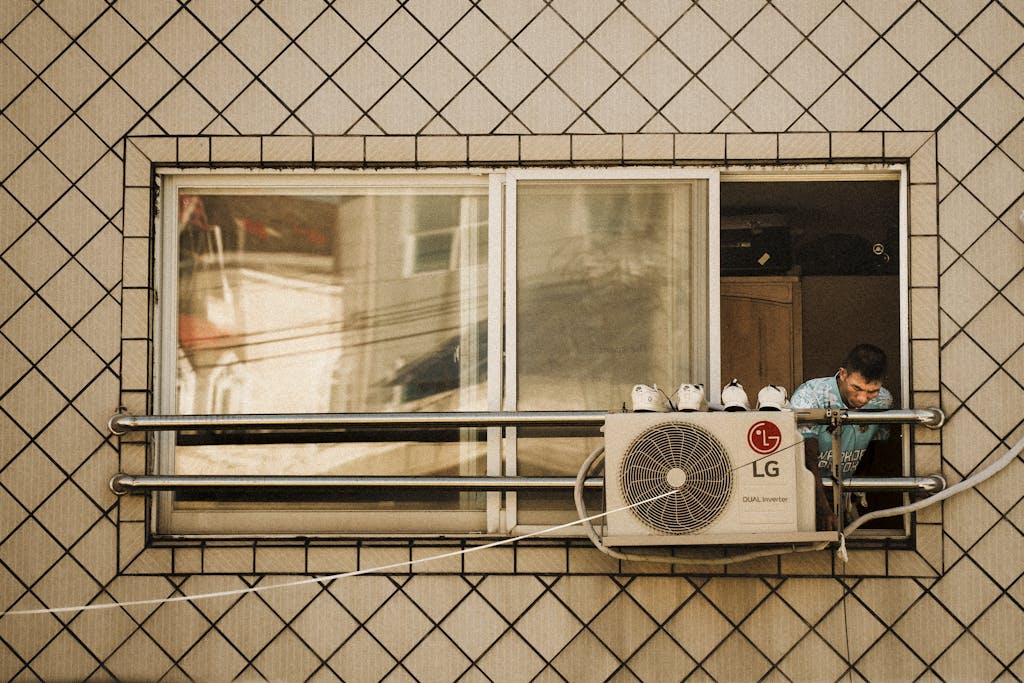Installing a new air conditioning system can significantly enhance indoor comfort, especially during the peak of summer. But to truly reap the benefits, it’s crucial to plan the process carefully. A successful air conditioning installation isn’t just about placing a unit in your home—it’s about evaluating needs, selecting the right system, and working with a qualified professional.

In this guide, we’ll break down the essential considerations for your next AC installation, ensuring optimal performance and energy efficiency.
1. Assessing Your Cooling Needs
Before choosing an air con unit, it’s important to understand your home’s specific cooling requirements. Factors that influence this include:
Square footage of your space
Insulation quality
Number of windows and their sun exposure
Local climate conditions
An improperly sized unit—whether too big or too small—can lead to inefficiencies, higher utility bills, and even system failure.
2. Choosing the Right Type of System
There are several types of air conditioning systems available today. Each serves a different purpose depending on the layout and needs of your home:
Split system air conditioner: Best for single rooms or small areas, with indoor and outdoor units connected by refrigerant piping.
Central air installation: Ideal for cooling multiple rooms through a network of ducts.
Ductless mini-split systems: Flexible solutions without the need for existing ductwork.
If your goal is to cool the entire home efficiently, a central air installation may be the most suitable. For older homes or renovations, split systems or ductless options offer flexibility and ease.
3. Prioritizing Energy Efficiency
Modern air conditioners offer a wide range of energy-saving features. Look for models with:
High SEER ratings (Seasonal Energy Efficiency Ratio)
Programmable thermostats
Variable-speed fans
An energy-efficient AC not only reduces environmental impact but also significantly cuts down on monthly cooling costs.
Additionally, pairing your unit with smart thermostats and regular maintenance schedules enhances its performance over time.
4. The Importance of Proper Ductwork
When opting for systems that rely on air ducts, the condition and layout of your ductwork matter a lot. Poorly designed or leaky ducts can lead to:
Uneven cooling
Increased energy consumption
Dust and pollutant circulation
Professional installers will inspect and optimize ductwork for AC during the setup process, sealing leaks and ensuring efficient airflow throughout the home.
5. Hiring a Certified HVAC Technician
A professional HVAC technician plays a critical role in a successful installation. Certified experts:
Ensure the system is sized properly
Follow safety and manufacturer guidelines
Handle refrigerants responsibly
Test the system post-installation
Choosing a reputable contractor ensures the residential AC setup complies with all local regulations and warranty requirements.
Look for technicians who are NATE-certified or have strong customer reviews in your local area.
6. Location Matters
Where your air con unit is installed affects both performance and durability. Ideally, your outdoor unit should be placed in a shaded, well-ventilated area away from debris. Indoor units should be mounted where they can distribute air evenly, preferably away from direct sunlight and heat sources.
Proper placement:
Reduces strain on the system
Promotes even cooling
Extends the life of the unit
During the planning phase, your technician will evaluate these factors to find the best installation spots.
7. Post-Installation Checklist
Once your AC installation is complete, ensure the following:
The unit powers on and off correctly
Thermostat is responsive
Airflow is consistent in all designated rooms
No odd noises or odors are present
The installer has walked you through basic operations and maintenance tips
Taking time to understand your new system’s controls will help you adjust settings for comfort and efficiency.
8. Long-Term Maintenance
Regular upkeep is key to maintaining performance and prolonging the lifespan of your air conditioner. Basic maintenance includes:
Changing filters every 1-3 months
Cleaning outdoor and indoor coils
Checking refrigerant levels
Scheduling annual inspections
Preventative maintenance not only ensures optimal cooling but also helps you catch small issues before they become expensive repairs.
9. Cost Considerations
Installation costs can vary based on:
Type of unit
Home size and layout
Ductwork condition or installation needs
Local labor rates
While it may be tempting to go with the cheapest quote, remember that quality installation impacts long-term performance and energy savings.
Also, many regions offer rebates or incentives for installing energy-efficient AC systems, which can offset upfront costs.
Conclusion
Investing in the right air conditioning installation can transform your home’s comfort and energy efficiency for years to come. From choosing the right air con unit to working with a professional HVAC technician, every step matters.
A well-executed residential AC setup with proper ductwork for AC ensures smooth operation during those sweltering summer months. By focusing on quality, efficiency, and expert guidance, you’ll enjoy a cooling system that performs reliably and economically.
Frequently Asked Questions (FAQs)
How long does AC installation take?
A typical AC installation takes 1–2 days, depending on system type and home layout.
Do I need permits for installing an AC unit?
Yes, many municipalities require permits. Your HVAC technician should handle this process.
Can I install my AC unit myself?
DIY installations are not recommended unless you’re certified. Incorrect setup can lead to performance issues or void warranties.
Installing a new air conditioning system can significantly enhance indoor comfort, especially during the peak of summer. But to truly reap the benefits, it’s crucial to plan the process carefully. A successful air conditioning installation isn’t just about placing a unit in your home—it’s about evaluating needs, selecting the right system, and working with a qualified professional.
In this guide, we’ll break down the essential considerations for your next AC installation, ensuring optimal performance and energy efficiency.
1. Assessing Your Cooling Needs
Before choosing an air con unit, it’s important to understand your home’s specific cooling requirements. Factors that influence this include:
- Square footage of your space
- Insulation quality
- Number of windows and their sun exposure
- Local climate conditions
An improperly sized unit—whether too big or too small—can lead to inefficiencies, higher utility bills, and even system failure.
2. Choosing the Right Type of System
There are several types of air conditioning systems available today. Each serves a different purpose depending on the layout and needs of your home:
- Split system air conditioner: Best for single rooms or small areas, with indoor and outdoor units connected by refrigerant piping.
- Central air installation: Ideal for cooling multiple rooms through a network of ducts.
- Ductless mini-split systems: Flexible solutions without the need for existing ductwork.
If your goal is to cool the entire home efficiently, a central air installation may be the most suitable. For older homes or renovations, split systems or ductless options offer flexibility and ease.
3. Prioritizing Energy Efficiency
Modern air conditioners offer a wide range of energy-saving features. Look for models with:
- High SEER ratings (Seasonal Energy Efficiency Ratio)
- Programmable thermostats
- Variable-speed fans
An energy-efficient AC not only reduces environmental impact but also significantly cuts down on monthly cooling costs.
Additionally, pairing your unit with smart thermostats and regular maintenance schedules enhances its performance over time.
4. The Importance of Proper Ductwork
When opting for systems that rely on air ducts, the condition and layout of your ductwork matter a lot. Poorly designed or leaky ducts can lead to:
- Uneven cooling
- Increased energy consumption
- Dust and pollutant circulation
Professional installers will inspect and optimize ductwork for AC during the setup process, sealing leaks and ensuring efficient airflow throughout the home.
5. Hiring a Certified HVAC Technician
A professional HVAC technician plays a critical role in a successful installation. Certified experts:
- Ensure the system is sized properly
- Follow safety and manufacturer guidelines
- Handle refrigerants responsibly
- Test the system post-installation
Choosing a reputable contractor ensures the residential AC setup complies with all local regulations and warranty requirements.
Look for technicians who are NATE-certified or have strong customer reviews in your local area.
6. Location Matters
Where your air con unit is installed affects both performance and durability. Ideally, your outdoor unit should be placed in a shaded, well-ventilated area away from debris. Indoor units should be mounted where they can distribute air evenly, preferably away from direct sunlight and heat sources.
Proper placement:
- Reduces strain on the system
- Promotes even cooling
- Extends the life of the unit
During the planning phase, your technician will evaluate these factors to find the best installation spots.
7. Post-Installation Checklist
Once your AC installation is complete, ensure the following:
- The unit powers on and off correctly
- Thermostat is responsive
- Airflow is consistent in all designated rooms
- No odd noises or odors are present
- The installer has walked you through basic operations and maintenance tips
Taking time to understand your new system’s controls will help you adjust settings for comfort and efficiency.
8. Long-Term Maintenance
Regular upkeep is key to maintaining performance and prolonging the lifespan of your air conditioner. Basic maintenance includes:
- Changing filters every 1-3 months
- Cleaning outdoor and indoor coils
- Checking refrigerant levels
- Scheduling annual inspections
Preventative maintenance not only ensures optimal cooling but also helps you catch small issues before they become expensive repairs.
9. Cost Considerations
Installation costs can vary based on:
- Type of unit
- Home size and layout
- Ductwork condition or installation needs
- Local labor rates
While it may be tempting to go with the cheapest quote, remember that quality installation impacts long-term performance and energy savings.
Also, many regions offer rebates or incentives for installing energy-efficient AC systems, which can offset upfront costs.
Conclusion
Investing in the right air conditioning installation can transform your home’s comfort and energy efficiency for years to come. From choosing the right air con unit to working with a professional HVAC technician, every step matters.
A well-executed residential AC setup with proper ductwork for AC ensures smooth operation during those sweltering summer months. By focusing on quality, efficiency, and expert guidance, you’ll enjoy a cooling system that performs reliably and economically.
Frequently Asked Questions (FAQs)
How long does AC installation take?
A typical AC installation takes 1–2 days, depending on system type and home layout.
Do I need permits for installing an AC unit?
Yes, many municipalities require permits. Your HVAC technician should handle this process.
Can I install my AC unit myself?
DIY installations are not recommended unless you’re certified. Incorrect setup can lead to performance issues or void warranties.





